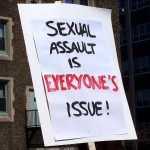“Women’s center” at Marywood University – I’m skeptical

image credit: teamawot.com
Sexual assault is a problem men and women face. A “women’s center,” excluding men, should not be welcome at Marywood University.
A graduate student at the university I attend — Marywood University in Scranton, Pennsylvania — is lobbying for a woman’s center to be included on campus. This prospective women’s center is proposed as a place where women are provided resources and information pertaining to sexual assault including “information, seminars, and assistance” according to an article in the university newspaper — The Wood Word — titled “Graduate student lobbying for women’s center on campus.”
Jennifer Mudge, the student spearheading this initiative, says that the center would provide “all students” such services and would be “inclusive,” [not only for victims of sexual assault, Mudge says] but the idea for the center has a very clear problem – men, according to the name of the prospective center, are excluded. The idea is to have a women’s center, not, for instance, a ‘sexual assault center’ or a ‘victim’s resource center,’ and is thus a poor exclusionary idea which ought to be reframed or scrapped altogether. I will argue that the center is poorly presented not only because it excludes men, but also because the reasoning for the center is deeply flawed – there is little to no good evidence that there is a need for a women’s center, or even any center pertaining to sexual assault, at Marywood Uuniversity.
Campus services at Marywood University should be offered to all individuals regardless of gender identification but, according to the article, the women’s center will not do that; men — including gay men and transgender individuals identifying as men — are excluded from the women’s center. This assumption is not just one from looking at the name of the center, but also from what Mudge offers in the article – “one in five college-age women will be sexually assaulted” Mudge says. Men are completely unmentioned while women are mentioned throughout. The concern does not appear to be sexual assault that all people — regardless of gender identification — face, but rather sexual assault women face.
Mudge notes that, when she was working with the Women’s Recourse Center in Scranton, she did not see a college-aged population which was consistent with the ‘1 in 5 women’ statistic she provides. The article, quoting Mudge, says, “We know [sexual assault] is happening regardless of how safe the campus is or how great the university is.” How do we know sexual assault is happening? Mudge simply assumes sexual assault is happening. She appears to extrapolate from statistics presumably representative of a whole — not Marywood University — in order to arrive at this conclusion. She appears to have a preconceived notion of the way things are and, when confronted with contrary information (a lack of sexual assault [reporting] at Marywood University), she clings to her belief rather than doubting the statistic. The article also notes that Mudge, through “conversations with individuals,” “have discovered that there is a discrepancy between what the university reports and what actually occurs.” We see no evidence whatsoever and just simply have to ‘take the word’ not only of Mudge, but also the accounts of the individuals.
The article notes that from 2011-2012, “there were four reported cases of sexual assault in 2011” at Marywood University. Dr. Amy Pacjej-Woodruff — dean of students at Marywood University — says that these reports “are only indicative of the cases which actually go through the conduct process.” Well, of course they are; Pacjej-Woodruff states the obvious with what seems to be some slippery language assuming that more cases of sexual assault exist when we have no reason (at least from what she provides) to assume this. It is also important to note that the reports of sexual assault — a grand total of four reports in a two-year period — are not necessarily indicative of four instances of sexual assault occurring on campus; the accusations may have been false and/or unfounded. Reports are much different than incidents of sexual assault.
Mudge, responding to comments from Pacjej-Woodruff, asserts that many instances of sexual assault go unreported due to stigmas associated with sexual assault. Even if this is the case, and I am sure that it is in some instances, this does not mean that there is a problem of sexual assault at Marywood University. If there is indeed a stigma associated with reporting sexual assault, this stigma almost certainly applies to men and women alike.
Is there a need for a women’s center, or better yet, a victim’s resource center at Marywood University? According to the presented data (four reports in the span of two years and anecdotal testimony relayed by a third-party) there does not appear to be a need for any sort of center.
If Marywood University does go ahead with plans for a center providing information and resources concerning sexual assault, it should not be a women’s center. A center pertaining to sexual assault should be for everyone – a victim’s resource center instead of a women’s resource center. Marywood University will unsuccessfully confront a problem of sexual assault — if it even exists at Marywood University — if Marywood only provides resources for women while completely ignoring the needs of men. Campus resources which are exclusionary on the basis of gender should not be tolerated at Marywood University. Men are also victims of sexual assault and should not be ignored.


Recent Comments